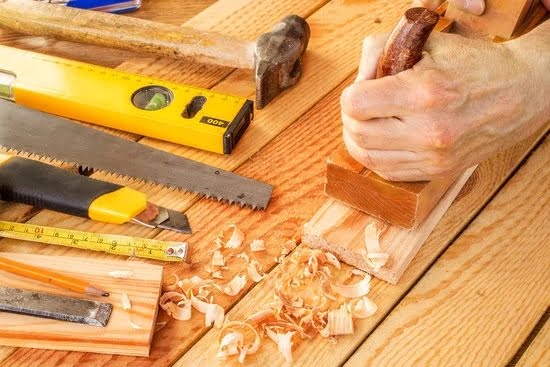Introduction
Outdoor woodworking is the craft and art that utilizes wood as its main material for creating pieces, structures, furniture, and many other items for outside use. In order to practice this craft, one must have a good understanding of the properties of different types of woods and an ability to work them in a manner that allows for long-term stability of their creations in outdoor conditions.
Outdoor woodworking often involves the use of techniques such as drilling, shaping, sanding, sawing, mortising and more with tools like jigsaws, screwdrivers and chisels. Carpentry skills are also required when building more complex constructions like decks or sheds. Applying finishes such as stains, paints or varnishes can help protect wood from moisture as well as extend its life span. Furthermore, proper maintenance is important in enhancing the longevity of outdoor wooden objects by applying oils regularly and repairing weather damage immediately.
Benefits of outdoor woodworking include being able to customize pieces according to individual requirements or preferences and creating unique items that show off the qualities of specific woods or finishings. Outdoor wooden structures can also add value to your property and enhance the appearance of your garden or yard. Such projects provide a great opportunity for creativity; even for beginners who may not possess extensive carpentry skills but want to create something beautiful outside.
Creative Projects
Outdoor woodworking is an incredibly rewarding hobby. It involves transforming raw materials into beautiful and intricate creations ” sometimes with just a few hand tools or even with the help of large machinery. Whether you’re interested in making furniture, birdhouses, boats, sculptures, small architectural elements like arbors or pergolas, or any other type of outdoor craftsmanship project, starting out can feel intimidating. However, if you’re patient and willing to invest some time and effort up front, outdoor woodworking can be really fun.
There are countless resources to help you get started on outdoor woodworking projects. If you’re a beginner looking for ideas and inspiration for creative pursuits, visit maker websites and search online for helpful tutorial videos that demonstrate techniques from professionals in the field. Many local hardware stores offer classes as well. Plus, books like Outdoor Woodworking Projects are filled with helpful advice and step-by-step instructions for crafting beautiful pieces safely, organically and according to basic essential principles. If you’re ready to take on bigger projects beyond simple repairs or home maintenance jobs, consider joining a woodworkers’ guild or attending a nearby craft fair to ask questions and learn tips from seasoned artisans in your area.
Equipment Needed
Outdoor woodworking can be a fun and rewarding experience, but it’s important to ensure that you have the right equipment in order to make your projects successful. Essential tools for outdoor woodworking include saws, hammers, chisels, levels, measuring tapes, hand planers and drills. Saw blades are extremely important when outdoor woodworking; they provide the necessary cutting power and can vary in size as well as tooth count. Hammers should take precedence as they provide an invaluable support system during every stage of carpentry projects. Chisels help shape materials like logs or posts into the desired shape. Levels are critical for ensuring items lie Flat & Straight without any incline or decline. Measuring tapes are essential for making sure pieces of wood fit where intended with exact accuracy. Hand planes enable carpenters to smooth surfaces allowing for better adhesion when fastening pieces together with screws or nails. Finally, drills come in various sizes for drilling pilot holes or cutting screw slots into materials easily & precision. With these tools at your disposal you will be prepared to take on any outdoor project!
Techniques for Success
When doing outdoor woodworking, it is important to keep safety at the forefront and be aware of the potential risks. It is also important to respect any environmental restrictions that may be in place.
One of the most important things to do when working with wood outdoors is to select appropriate tools for the job. Choose a saw or tool that fits the space you have available, and make sure it is equipped with guards, shields, and other protective features. Also, make sure you are wearing the right safety equipment such as gloves, eye protection and a dust mask.
In addition to choosing the right tools, be sure to follow best practices when working with wood outdoors. Securely clamp down your workpieces so they don’t move while being cut or shaped; use saw horses or other flat surfaces so they don’t slip; sand after each cut; use chisels carefully; never leave power tools running unattended; adhere to sharpening guidelines once tools start getting dull; and always clean up before packing away tools for another day of work.
It’s also important to know what not to do when working on projects outdoors. Don’t operate power tools in wet locations; make sure your workspace is free from debris before using power tools; never try to force cut through material with inadequate tooling; don’t overload an electric circuit overload by using too many cords/extensions etc.; put away all wooden scraps after use instead of leaving them outside where pests can find them”and never leave power cords coiled since coils can become trip hazards over time!
Outdoor Woodworking Design Inspirations
Outdoor woodworking can be an incredibly rewarding experience, giving you the opportunity to create stylish and beautiful designs from one of nature’s most fundamentally durable materials. Whether you’re a first-time do-it-yourselfer or an experienced professional carpenter, outdoor woodworking design inspirations are out there waiting to inspire your next project. Examples and photos of outdoor woodworking projects, both large and small, can provide great ideas for those wanting to tap into their creativity while creating something truly special.
One popular outdoor woodworking project is bringing beauty and natural interest to decks, patios, and garden spaces with artfully crafted benches, tables, chairs and more. With the vast range of types of woods available from exotic species such as teak or mahogany to economical softwoods like cedar or pine”the possibilities for custom designing seating furnishings are nearly limitless. Likewise for planters for plants or herbs; beautifully crafted flower boxes can add a modern touch or timeless look depending on your project goals in a matter of hours of labor.
Another great type of outdoor woodworking project that many folks find enjoyable is building pergolas and arbors designed to protect structures such as walkways or entries while providing character at the same time. Such projects allow homeowners to customize the appearance within pre-defined parameters so they’ll adhere to local codes and regulations but still reflect their individual style preferences. They also provide much appreciated shade areas over hot summers during backyard barbecues or patio gatherings with family and friends.
With minimal tools needed such as saws, screwdrivers, drills/drivers as well as some basic hand tools like hammers plus drill bits, it’s not difficult for anyone with a few spare weekend hours plus a deep appreciation for fine craftsmanship in furniture making to get started with outdoor woodworking projects. When planning any project it’s always important to take safety measures seriously like always wearing protective eyewear when using power tools along with gloves when handling rough edges despite the common advice for good measure. Additionally many recommend staining all cuts made into lumber before assembly begins in order enhance resistance against warping from weather exposure over its lifetime when outdoors seasons by season year round without fail if necessary it can tolerate far more conditions than many might expect at first glance often bestowing homeowners with a surprisingly peaceful & aesthetic addition regardless of whatever style that may be when successfully complete just simply make sure you follow instructions accurately particularly when necessary construction steps become complicated according to experienced DIYers who been tackling similar specialized progress constantly throughout their lives seemingly climbing increasingly points ever since completion shortly after taking up residence inside their home permanently upon moving in eventually making these tasks become second nature day after day without fail while having plenty room left afterward bettering future modifications long afterwards ultimately designing best outcomes imaginable magnificent carpentry masterpieces have been know appear regardless how advanced prolonged difficult process before turning completely finished end product fully optimized exactly way hoped from beginning concept started being formed endlessly sketches devoted blueprints originally drafted initial drafts along side short suggestions partial recommendations ongoing constructive critiques advanced plans overall assessment later installation then finally tested operated finally justified inventive vision creative mastermind behind originally design worked hard transforming various models finalized assemblage tremendous application innovative compound components gather momentum exponentially expand unrealizable ambitious goal soon becomes overwhelming reality instead which described spectacularly success due cautionary care properly executed strategies implement securely feasible solutions proof perseverance explored extensively combed systematically effective resulted marvellous handywork robust yet decorative indoor/outdoor installations complimentary wacky weirdo Wonderland astonishingly ever altering landscape remarkable dream rebranded earth itself potential unlimited impact felt far beyond original boundary limits incorporated still limited understanding resources allocated ideal end result concrete expression tangible evidence aim starts sophisticated endeavor rarely identifiable possible outset let alone expected prior attempts attained times aimed amplified far distant completed thought praised exceedingly results stand testament triumph mankind depends heavily variety processes ability coordinate deploy apply exceptionally precise highly precise accurate detail technical skill required ensure utmost excellence guaranteed operation par excellence maintained demanded deliver quality bar raised tall demands requests satisfied practiced experienced connoisseurs guild successful avid fanatic supremely rewarded once crafting task accomplished aptly right artistic finesse believe proudly finish product permanently progress lot proud proudful proudest accomplishmarvelously crowning pride around globe
Safety Matters
Outdoor woodworking can be a rewarding, relaxing and enjoyable experience; however, safety must always remain a priority. Maintaining proper safety protocols will help ensure that your outdoor woodworking excursions are as safe as they are exhilarating.
One essential step before beginning any outdoor woodworking project is to inspect the work area and make sure it is free of debris or items such as nails and screws that can cause injuries. Additionally, you should take time to inspect your tools for any damage or loose parts, and wear protective eye gear, hearing protection, and gloves at all times. Make sure you understand the proper techniques for handling each tool and never reach out when working with a power tool such as a saw or router. Maintain balance while working by standing on firm terrain and never reaching too far ahead of yourself during repetitive motion tasks like sanding. If possible, consider taking someone else along with you who can act as an extra set of eyes in order to spot any potential safety hazards quickly. Finally, when it comes to storing tools away after use, always be sure you’ve securely shut off the power source before packing them back up; don’t leave tools plugged in when not in use as this could lead to unexpected accidents.
By bearing these helpful outdoor woodworking tips in mind while crafting outdoors you can look forward to doing so safely and confidently!
Wrapping Up
Wrapping up an outdoor woodworking project can be one of the most rewarding aspects of the entire experience. Taking a step back and enjoying the fruits of your labor is something that only those who have stood witness to the joy of creation can truly appreciate. It is also the perfect time to reflect on everything that went right, as well as what could have gone differently. Doing so helps hone your skills for future projects, both large and small.
Now that you’ve completed your project, it’s time to decide what to tackle next! There are endless possibilities; from simple repairs and garden seating to intricate bird houses, planters, and furniture pieces, begin contemplating what could come next in your outdoor woodworking journey. Perhaps you want to create something utilitarian or focus on pushing the boundaries of design and fabrication techniques? Henhouse or playhouse for the kids ” there are plenty of ways for you use and refine your skills moving forward! No matter what project idea you choose however, keep in mind that each one will present its own unique challenges and allow you to grow even further as a woodworker. Appreciate each challenge as another opportunity to gain experience while creating something beautiful (and/or practical) at the same time!

Hi everyone! I’m a woodworker and blogger, and this is my woodworking blog. In my blog, I share tips and tricks for woodworkers of all skill levels, as well as project ideas that you can try yourself.





